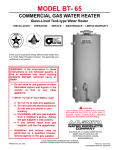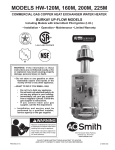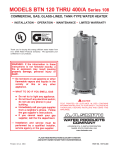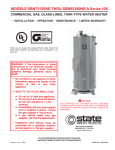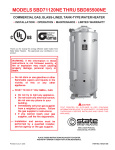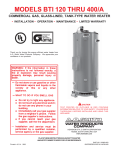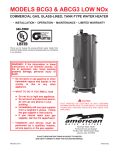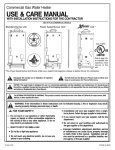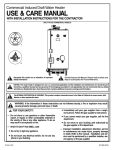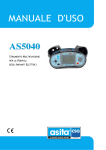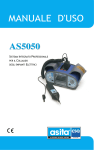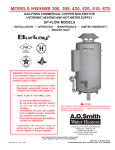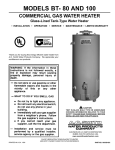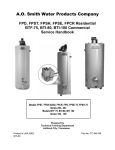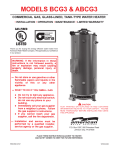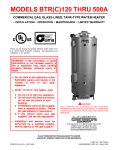Download A.O. Smith 160M Fan User Manual
Transcript
MODELS HW-120M, 160M, 200M, 225M COMMERCIAL GAS COPPER HEAT EXCHANGER WATER HEATER BURKAY UP-FLOW MODELS Including Models with Intermittent Pilot Ignition (I.I.D.) • Installation • Operation • Maintenance • Limited Warranty WARNING: If the information in these instructions are not followed exactly, a fire or explosion may result causing property damage, personal injury or death. —Do not store or use gasoline or other flammable vapors and liquids in the vicinity of this or any other appliance. —WHAT TO DO IF YOU SMELL GAS • • • • CAUTION TEXT PRINTED OR OUTLINED IN RED CONTAINS INFORMATION RELATIVE TO YOUR SAFETY. PLEASE READ THOROUGHLY BEFORE USING APPLIANCE. Do not try to light any appliance. Do not touch any electrical switch; do not use any phone in your building. Immediately call your gas supplier from a neighbor’s phone. Follow the gas supplier’s instructions. If you cannot reach your gas supplier, call the fire department. A DIVISION OF A.O. SMITH CORPORATION McBEE, SOUTH CAROLINA, USA RENTON, WA, USA STRATFORD, ONTARIO, CANADA VELDHOVEN, THE NETHERLANDS www.hotwater.com — Installation and service must be performed by a qualified installer, service agency or the gas supplier. PLACE THESE INSTRUCTIONS ADJACENT TO HEATER AND NOTIFY OWNER TO KEEP FOR FUTURE REFERENCE PRINTED IN U.S.A. 0905 1 PART NO. 212626-000 SUPERSEDES PART NO. 192011- 000 REV.4 ROUGH-IN-DIMENSIONS TABLE 1 - ROUGH-IN DIMENSIONS Models Dimensions A B C D E F G H J K L M N W Approx. Shipping Weight HW-120M Inches mm 49 3/8 1254 30 3/8 772 23 5/8 600 20 3/4 527 5 1/2 140 10 254 11 13/16 300 6 152 26 11/16 678 20 3/4 527 1 1/4 NPT 1 NPT 1/2 NPT 1 3/4 44 HW-160M Inches mm 50 1/8 1273 30 3/8 772 23 5/8 600 20 3/4 527 5 1/2 140 10 254 11 13/16 300 7 178 26 11/16 678 20 3/4 527 1 1/4 NPT 1 NPT 1/2 NPT 1 3/4 44 HW-200M Inches mm 53 1/4 1353 33 1/8 841 27 1/8 689 20 3/4 527 5 1/2 140 10 254 11 13/16 300 7 178 26 11/16 678 20 3/4 527 1 1/4 NPT 1 NPT 1/2 NPT 1 3/4 44 HW-200M Inches mm 60 1524 33 1/8 841 27 1/8 689 20 3/4 527 5 1/2 140 10 254 11 13/16 300 7 178 26 11/16 678 20 3/4 527 1 1/4 NPT 1 NPT 1/2 NPT 1 3/4 44 120 lbs. 155 lbs. 165 Lbs. 175 lbs. 54 Kg. 70 Kg. 75 Kg. 79 Kg. HEATER PERFORMANCE DATA NOTE: To compensate for the effects of high altitude areas above 2000 feet, input rating, and therefore recovery ratings, should be reduced approximately 4% for each 1000 feet above sea level. TABLE 2 - RECOVERY CAPACITIES U.S. Gallons/Hrs. and Litres/Hr. at TEMPERATURE RISE INDICATED Input Model HW-120M HW-160M Btuh F° KW 120,000 35 160,000 47 HW-200M HW-2250M 199,000 58 225,000 66 C° 20F° 30F° 36F° 40F° 50F° 54F° 60F° 70F° 72F° 11.1C° 16.6C° 20C° 22.2C° 27.7C° 30C° 33.3C° 38.8C° 40C° 100F° 108F° 110F° 120F° 126F° 130F° 140F° 44.4° 50C° 55.5C° 80F° 90F° 60C° 61.1C° 66.6C° 70C° 72.2C° 77.7C° GPH 605 403 336 303 242 224 202 173 168 151 134 121 112 110 101 96 93 86 LPH 2290 1527 1272 1145 916 848 763 654 636 573 509 458 242 416 382 364 352 327 GPH 777 518 432 388 311 288 259 222 216 194 173 155 144 141 129 123 120 111 LPH 2941 1961 1634 1471 1176 1089 980 840 817 735 654 588 545 535 490 467 452 420 GPH 987 658 548 494 395 366 329 282 274 247 219 197 183 179 165 157 152 141 LPH 3737 2491 2076 1869 1495 1384 1246 1068 1038 934 830 747 692 679 623 593 575 534 GPH 1096 731 609 548 438 406 365 313 304 274 244 219 203 199 183 174 169 157 LPH 4149 2766 2305 2074 1659 1537 1383 1185 1152 1037 922 830 768 754 691 659 638 593 Recovery rating of models shown in chart above are obtained by actual efficiency test data by recognized Certification Agency. NOTE: Recovery rate shown on each models rating plate is based on the requirements of ANSI Standard Z21.10.3, which stipulates the data to be based on energy efficiency of 75%. TABLE 3 - CAPACITY AND GAS AND ELECTRIC CHARACTERISTICS Manifold Pressure Model Type of Gas Inches W.C. kPa HW-120M thru 225M NATURAL 3.5 0.87 HW-120M thru 200M PROPANE 10 2.49 Maximum Supply Pressure Inches W.C. kPa 10.5 2.61 13.0 3.23 Minimum Supply Pressure, Natural Gas: 4.5 inches W.C. (1.12 kPa) Minimum Supply Pressure, Propane Gas: 11.0 inches W.C. (1.74 kPa) Minimum Pressure must be maintained under both load and no load (static and dynamic) conditions. 2 Electrical Characteristics Volts/Hz Amperes 120/60 <5 120/60 <5 FOREWORD The factory warranty will be void if the unit(s) have been improperly installed or operated. This design complies with the latest edition of the ANSI Standard Z21.10.3 for gas water heaters Vol. III Storage Water Heaters with input ratings above 75,000 BTU per hour Circulating and Instantaneous. In addition to these instructions, the boiler(s) shall be installed in accordance with those installation regulations in force in the local area where the installation is to be made. These shall be carefully followed in all cases. Authorities having jurisdiction should be consulted before installations are made. Detailed installation diagrams are in this manual. These diagrams will serve to provide the installer with a reference for the materials and method of piping suggested. IT IS ESSENTIAL THAT ALL WATER AND GAS PIPING AND THE ELECTRICAL WIRING BE INSTALLED AND CONNECTED AS SHOWN IN THE DIAGRAMS. In absence of local codes, the installation must comply with the latest editions. You should thoroughly read and understand this manual before installation and operation of this unit. In the United States: The National Fuel Gas Code, ANSI Z223.1 and the National Electric Code, NFPA 70. CHECK THE DIAGRAMS THOROUGHLY BEFORE STARTING INSTALLATION TO AVOID POSSIBLE ERRORS AND TO MINIMIZE TIME AND MATERIALS COST. In Canada: The Installation Code CAN/CGA B149.1 and .2 (latest edition) and the Canadian Electric Code, CSA C22.1. Particular attention should be given to the installation of thermometers at the locations indicated in the diagrams as these are necessary for checking the operation of the heater. These are available from the Canadian Standards Association, 8501 East Pleasant Valley Road, Cleveland, OH 44131, USA, or, Canadian Gas Association Laboratories, 55 Scarsdale Road, Don Mills, Ontario M3B 2R3, Canada. MAKE SURE THE GAS ON WHICH THE HEATER WILL OPERATE IS THE SAME AS THAT SPECIFIED ON THE HEATER MODEL AND RATING PLATE. TABLE OF CONTENTS PAGE ROUGH-IN DIMENSIONS .................................................................. FOREWORD ....................................................................................... GENERAL SAFETY INFORMATION .................................................. Precautions .................................................................................... Grounding Instructions ................................................................... Chemical Vapor Corrosion ............................................................. Liquid Petroleum Models ................................................................ High Altitude Installations ............................................................... FEATURES ......................................................................................... Automatic Gas Shutoff Control ....................................................... Protector Switch (Coil High Limit) ................................................... Thermal Balancer ........................................................................... Intermittent Ignition Control Module ................................................ Circulating Pump ............................................................................ Tank Temperature Control (Not Supplied) ...................................... Safety Flow Switch (Not Supplied) ................................................. Drain Valve (Not Supplied) ............................................................. Thermometers (Not Supplied) ........................................................ INSTALLATION INSTRUCTIONS ....................................................... Important ........................................................................................ Required Ability .............................................................................. Location ......................................................................................... Installation Clearances ................................................................... Levelling ......................................................................................... Air Requirements ........................................................................... Venting ........................................................................................... Relief Valve .................................................................................... Hard Water ..................................................................................... Closed Water System .................................................................... Water Line Connections ................................................................ Water (Potable) Heating ................................................................ PAGE 2 3 3 3-4 4 4 4 4 5 5 5 5 5-6 6 6 6-7 7 7 8 8 8 8 8 8 8-9 9 9-10 10 10 10 10 PIPING DIAGRAMS ............................................................................ Gas Connections ........................................................................... Electrical Information ..................................................................... OPERATION ........................................................................................ Important ....................................................................................... General ........................................................................................... Filling .............................................................................................. Purging Of Gas Line ...................................................................... Operating Instructions For I.I.D Models. ....................................... Checking And Adjusting The Input ................................................. SERVICE INFORMATION .................................................................. Pilot And Main Burner Maintenance ............................................... I.I.D. Pilot Burner ........................................................................... Protector Switch (Coil High Limit-All Heaters) ............................... Tank Temperature Control .............................................................. Automatic Gas Shutoff Control ..................................................... Thermal Balancer ........................................................................... Inspecting The Heat Exchanger And Venting System .................. Gas Pressure Regulator ................................................................ Relief Valve ................................................................................... Circulating Pump ............................................................................ Electrical Service ........................................................................... Replacement Parts ........................................................................ PREVENTIVE MAINTENANCE ........................................................... Recommended Procedure For Periodic Removal Of Lime Deposits From Coil Type Commercial Water Heaters ................. Deliming Solvents .......................................................................... Removing Light Deposits .............................................................. Heavy Lime Deposits ................................................................... CHECKOUT ........................................................................................ LIMITED WARRANTY ........................................................................ 11-13 14-15 15-16 17 17 17 17 17 18 19 20 20 20-21 21 21 21 21 21-22 22 22 22 22 22 22 22-23 23 23 23-24 24-27 28 GENERAL SAFETY INFORMATION 3. IF DAMAGED. PRECAUTIONS 4. FIRING WITHOUT WATER. If the unit is exposed to the following, do not operate heater until all corrective steps have been made by a qualified serviceman: 5. SOOTING. KEEP THE HEATER AREA CLEAR AND FREE FROM COMBUSTIBLE MATERIALS, GASOLINE AND OTHER FLAMMABLE VAPORS AND LIQUIDS. AREA AROUND HEATER MUST NOT CONTAIN OBSTRUCTING MATERIAL TO THE FLOW OF COMBUSTION AND VENTILATING AIR. 1. FLOODING TO LEVEL OF BURNER OR CONTROLS OR HIGHER. 2. EXPOSURE TO FIRE. 3 HIGH ALTITUDE INSTALLATIONS SHOULD OVERHEATING OCCUR OR THE GAS SUPPLY FAIL TO SHUT OFF, TURN OFF THE MANUAL GAS CONTROL VALVE TO THE APPLIANCE. WARNING INSTALLATIONS ABOVE 2000 FEET REQUIRE REPLACEMENT OF THE BURNER ORIFICE IN ACCORDANCE WITH SECTION 8.1.2 OF THE NATIONAL FUEL GAS CODE (ANSI Z223.1). FOR CANADIAN INSTALLATIONS CONSULT CANADIAN INSTALLATION CODES AND CAN/CGA B149. FAILURE TO REPLACE THE ORIFICES WILL RESULT IN IMPROPER AND INEFFICIENT OPERATION OF THE APPLIANCE RESULTING IN THE PRODUCTION OF INCREASED LEVELS OF CARBON MONOXIDE GAS IN EXCESS OF SAFE LIMITS WHICH COULD RESULT IN SERIOUS PERSONAL INJURY OR DEATH. Heater must be protected from freezing downdrafts during shutdown periods. GROUNDING INSTRUCTIONS This water heater must be grounded in accordance with the National Electric Code and/or local codes. These must be followed in all cases. This water heater must be connected to a grounded metal, permanent wiring system; or an equipment grounding conductor must be run with the circuit conductors and connected to the equipment grounding terminal or lead on the water heater. You should contact your gas supplier for any specific changes which may be required in your area. As elevation above sea level is increased, there is less oxygen per cubic foot of gas. Therefore, the heater input rate should be reduced at high altitudes for satisfactory operation with the reduced oxygen supply. Failure to make this reduction could result in an overfiring of the heater, causing sooting, poor combustion and/or unsatisfactory heater performance. CHEMICAL VAPOR CORROSION WARNING CORROSION OF THE FLUEWAYS AND VENT SYSTEM MAY OCCUR IF AIR FOR COMBUSTION CONTAINS CERTAIN CHEMICAL VAPORS. SUCH CORROSION MAY RESULT IN FAILURE AND RISK OF ASPHYXIATION. U.S. REQUIREMENTS Ratings specified by manufacturers for most appliances apply for elevations up to 2000 feet (610m). For elevations above 2000 feet (610m), ratings must be reduced at the rate of 4% for each 1000 feet (305m) above sea level. For example, if a heater is rated at 120,000 Btuh (35 Kwh) at sea level, to rate the heater at 4000 feet (1219m), you subtract 4 (once for each thousand feet) x .04 (4% input reduction) x 120,000 (original rating) from the original rating. Therefore, to calculate the input rating at 4,000 feet (121.9m): 4 x .04 x 120,000=19,200 Btuh (5.6 Kwh), 120,000 (35 Kwh) - 19,200 (5.6Kwh)=100,000 Btuh (29.4 Kwh). At 6000 feet (1829m) the correct input rating should be 91,200 Btuh (26.7 Kwh). Spray can propellants, cleaning solvents, refrigerator and air conditioning refrigerants, swimming pool chemicals, calcium and sodium chloride (water softener salt), waxes, and process chemicals are typical compounds which are potentially corrosive. Do not store products of this sort near the heater. Also, air which is brought in contact with the heater should not contain any of these chemicals. If necessary, uncontaminated air should be obtained from remote or outside sources. The limited warranty is voided when failure of water heater is due to a corrosive atmosphere. (Refer to the limited warranty for complete terms and conditions.) CANADIAN REQUIREMENTS LIQUID PETROLEUM MODELS Appliances with inputs up to and including 400,000 BTU (117.2 Kw) must be factory equipped with orifices for operation at specific elevations. Standard (sea level) orifices permit operation up to 2000’ (610m) elevation. For operation between 2000’ (610m) and 4500’ (1370m) specify “HIGH ALTITUDE OPERATION” when ordering the heater(s). For operation above 4500’ (2370m) consult factory before ordering. Water heaters for propane or liquefied petroleum gas (LPG) are different from natural gas models. A natural gas heater will not function safely on LP gas and no attempt should be made to convert a heater from natural to LP gas. LP gas must be used with great caution. It is highly explosive and heavier than air. It collects first in low areas making odor difficult to detect at nose level. If LP gas is present or even suspected, do not attempt to find the cause yourself. Go to a neighbor’s house, leaving your doors open to ventilate the house, then call your gas supplier or service agent. Keep area clear until a service call has been made. Field conversion for operation at altitudes other than that specified on the heater rating plate is not permitted. The input reduction is primarily achieved by reducing the size of the main burner orifice. To do this, the main burner orifices require replacement with orifices sized for the particular installation elevation. Correct orifice sizing and parts may be obtained from A.O. Smith Water Products Company. When ordering, be sure to state the model number and the altitude of the location where the water heater is being installed. At times you may not be able to smell an LP gas leak. One cause is odor fade, which is a loss of the chemical odorant that gives LP gas its distinctive smell. Another cause can be your physical condition, such as having a cold or diminishing sense of smell with age. For these reasons, the use of a propane gas detector is recommended. Upon completion of derating of the heater, adjustment to the gas pressure regulator may be required. See CHECKING THE INPUT section in this manual for inlet and manifold pressure requirements. IF YOU EXPERIENCE AN OUT-OF-GAS SITUATION, DO NOT TRY TO RELIGHT APPLIANCES YOURSELF. Only trained LP professionals should conduct the required safety checks in accordance with industry standards. Also due to the input rating reduction required at high altitudes, the output rating of the appliance is reduced and should be compensated for in the sizing of the equipment for the application. 4 FEATURES TABLE 4. Control Device Factory Setting Field Adjustment Heater Protector Switch 1950F Fixed 1900F 2500F Fixed 2000F Tank Temperature Control Field Supplied and Installed Adjust to Requirements Safety Flow Switch See Table 1 Field Adjustable Heater Automatic Gas Shutoff Control (90.5°C) cut out temp. (87.7°C) cut in temp. (121°C) cut out temp. (93.3°C) cut in temp. Non-adjustable Non-adjustable AUTOMATIC GAS SHUTOFF CONTROL The automatic gas shutoff control, fig. 1, is an automatic safety device which activates at a water temperature of approximately 1950F (90.5°C). This limits the water outlet temperature to a maximum of 2000F (87.7°C). The device is wired in series with the gas valve. The control will automatically reset when the water temperature cools to approximately 190oF (87.7°C). Should the automatic gas shutoff control activate during a heating cycle, the heater’s gas valve will close; extinguishing the main burners. The pilot burner will also be extinguished. The circulating pump will continue operating as long as the storage tank thermostat continues to “call for heat”. When the water temperature in the heater drops to 1800F (82.2°C) or below the control module will begin an ignition cycle which will relight the pilot burner and main burners. Re-ignition of the main burners will occur if the storage tank thermostat continues to call for heat. Otherwise, the normal operating cycle will resume on the thermostat’s next call for heat. FIGURE 2 DO NOT RESET THIS SWITCH WITHOUT PERFORMING THE SYSTEM CHECKS OUTLINED UNDER PROTECTOR SWITCH IN THE SERVICE INFORMATION SECTION. ALSO, SEE CHART ONE UNDER THE CHECKOUT SECTION. IF NECESSARY, CALL A QUALIFIED SERVICEMAN. Once the cause of the protector switch activation has been determined and corrected, it will be necessary to restart the heater following the LIGHTING AND OPERATING instructions. THERMAL BALANCER The thermal balancer (standard on Models HW-200M and HW-225M, optional on Models HW-120M and HW-160M) is a snap-acting single-pole thermal relay used only on Cer-Temp 80 Recovery systems. It gives immediate pump start but delay of pump shutoff for approximately 2 minutes. Residual heat in the heat exchanger is then recovered after shutdown. This improves efficiency and balances heater temperature with tank temperature at shutdown. AUTOMATIC GAS SHUTOFF CONTROL FIGURE 1 INTERMITTENT IGNITION CONTROL MODULE The Honeywell S-8600 control module contain the electronic components of the system and also serve as a central wiring system for the controls mounted on the heater. The control module performs the following functions: PROTECTOR SWITCH (Coil High Limit) This heater is equipped with a manually reset protector switch, Figure 2, located under the small cover on the side of the jacket. This device provides positive shutdown of the heater in the event of heater or system malfunction. Should the surface temperature of the copper tubing heat exchanger reach 2500F (121.1°C), the protector switch will activate. The gas valve will close, and the pilot and main burners will be extinguished. To resume heater operation, the protector switch must be manually reset (remove the protector switch cover and push the reset button) after the coil surface temperature cools to less than 2000F(93.3°C). 1. Checks for safe-start by sensing for a flame or false flame condition on start-up. 2. Generates a potential of 15,000 volts for spark ignition of the pilot burner. 3. Opens the pilot valve. 5 Follow the same oiling procedure if a replacement circulator is installed into the system. 4. Discontinues ignition spark when the pilot flame is established. The S-8600 control used on propane gas models provides safety lockout if the pilot fails to ignite within the pilot flame establishing period. The S-8600 control used on natural gas models continues trial for ignition until pilot flame is established. TANK TEMPERATURE CONTROL (Not Supplied) 5. After proof-of-pilot flame, opens the main valve. DANGER USE ANTI-SCALD VALVE(S) in the hot water system to reduce the risks of scalds at points of use such as lavatories, sinks and bathing facilities. 6. On a power loss, shuts the heater down. When power is restored it will begin a new ignition cycle. 7. On a loss of flame, shuts off main gas and starts trial for pilot ignition. The tank temperature control is located in the lower portion of the hot water storage tank, see PIPING DIAGRAMS. It is the primary operating control of the system and regulates the water temperature in the tank. The storage tank thermostat should have contact ratings that exceed the maximum electrical requirements of the system. Typically, the thermostat should have motor full load and locked rotor current ratings which exceed the total amount of current required to drive the pump(s) controlled by the thermostat. The thermostat should have a temperature range of 1000F (37.7°C) to 1800F (82.2°C) or more. The preferred initial setting for the storage tank thermostat is 1200F (48.8°C). However, for normal use, the thermostat should be adjusted to the lowest setting which produces an acceptable hot water supply temperature. This will always give the most energy efficient operation. Do not adjust the thermostat to achieve a storage temperature of 190oF (87.7°C) or above. This action may cause the automatic gas shutoff control to activate shutting down the heater. INTERMITTENT IGNITION CONTROL MODULE (I.I.D.) FIGURE 3 Intermittent ignition device and circulator start and stop simultaneously as the tank thermostat contacts open and close. This basic action, water flowing whenever the burner operates, must not be altered. CIRCULATING PUMP Constant circulating pump operation of the heater voids the warranty. Constant water flow through the unit will “wash” away the copper’s natural protective coating. This is called velocity erosion. This erosion is not as great a problem when intermittent circulating operation is used per the recommended installation procedure. Constant circulation of water between the storage tank and the building is permissible as long as the water does not constantly flow through the heater. SAFETY FLOW SWITCH (Not Supplied) The safety flow switch is a safety device installed at the water outlet of the unit to prevent main burner operation in the event of inadequate water flow through the unit. Only all bronze circulators are used with commercial water heaters. An accessory package A.O.S. No. 211480 containing a safety flow switch is available for this application. Although circulators are oiled and operated by the manufacturer, THEY MUST BE OILED AGAIN BEFORE OPERATED. Oil the three oil cups (2 on the motor, 1 on the pump) as instructed by manufacturer. See fig. 4. This switch may be mounted in a horizontal pipe line or a vertical pipe line with upward water flow. Do not install the switch where the water flow is downward. Thereafter, lubricate the three oil cups at least once every 4 months. For proper performance mount the switch in a section of pipe where there is a straight run of at least 5 pipe diameters on each side of the flow switch (i.e. do not locate adjacent to valves, elbows, orifices, etc.). The flow switch shall be mounted in a standard 1" x 1" x 1" tee for a 1" pipe application. For larger pipe sizes use a reducing tee in order to keep the switch as close to the pipe as possible. Install the flow switch in the branch (top) opening of the reducing tee and provide adequate paddle length in the flow stream. For example in a 2" pipe installation use a 2" x 2" x 1" reducing tee. For 1", 2" or 3" pipe use the paddle segments as supplied. For other pipe sizes (i.e. 1 1/4", 1 1/2", and 2 1/2") trim the paddle to the proper pipe size, see fig. 5. If a standard tee is used, install a face or hex bushing in the top opening. The paddle must be adjusted or trimmed to the size of the pipe in which it will be installed. TYPICAL CIRCULATING PUMP FIGURE 4 Use 2 or 3 teaspoonsful in bearing oil cups, and 10 or 12 drops in the motor oil cups. Use no. 20 non-detergent motor oil. 6 CAUTION: The paddle must be trimmed at the dotted arc. It must not touch the pipe or any restrictions when installed. FIGURE 5 The installer is cautioned to follow the manufacturer’s instructions exactly when inserting this switch into a pipe tee. This is necessary in order to assure positive action of the switch with water flow. Once the minimum flow rate (Table 5) through the heater is reached, the safety flow switch contacts close and consequently, main burner operation is achieved. CAUTION Any part of the paddle must not touch the pipe or any restrictions in the pipe. Screw the flow switch in position so the flat of the paddle is at right angles to the flow. The arrow on the side case must point in the direction of the flow. The safety flow switch may be field adjusted to obtain higher minimum flow rates than those shown in Table 5. DRAIN VALVE (Not Supplied) To adjust the flow rate setting: A drain valve must be obtained and installed on each heater and tank for draining purposes, see installation diagrams in this manual. 1. Remove the flow switch cover. 2. For higher flow rate—turn the range adjusting screw clockwise. 3. For lower flow rate—turn the range adjusting screw counterclockwise. THERMOMETERS (Not Supplied) Thermometers should be obtained and field installed as shown in the installation diagrams. CAUTION The switch is factory set at approximately the minimum flow rate, see Table 5. It must not be set lower than the factory setting as this may result in the switch failing to return at a “no flow” condition. Thermometers are installed in the system as a means of detecting a possible liming condition in the heater. An increase of 50F over the normal temperature rise through the heater is an indication that lime is present. The term “temperature rise” designates the difference between the heater inlet and outlet water temperatures. 4. Replace the flow switch cover. TABLE 5 - SAFETY FLOW SWITCH SETTINGS Model HW-120M,160M HW-200M HW-225M An increase of 50F (3°C) above the recorded temperature rise may signify a liming condition in the coils or heat exchanger. Refer to PREVENTIVE MAINTENANCE section of this manual for deliming instructions. Minimum Flow Rate (GPM) Contacts Close Contacts Close Pkg. GPM LPM GPM LPM No. 0.6 2.3 0.3 1.1 211480 4.2 15.9 2.5 9.5 211480 5.8 22.0 3.7 14.0 211480 Record temperature rise at initial start-up for future reference. 7 INSTALLATION INSTRUCTIONS IMPORTANT For appliance installation in locations with elevations above 2,000 feet (600M), refer to HIGH ALTITUDE INSTALLATIONS section of this manual for input reduction procedure. Strict adherence to installation wiring diagrams shown in this manual is required to prevent constant pump operation when the system temperature control is satisfied, otherwise the warranty is void as stipulated under item 2a (6) of the LIMITED WARRANTY. INSTALLATION CLEARANCES These units are approved for installation in an alcove having minimum clearances from combustible construction of 44" (1,118mm) from top of the jacket, 6" (152.4mm) from sides, and 6" (152.4mm) from rear and vent connections. REQUIRED ABILITY INSTALLATION OR SERVICE OF THIS WATER HEATER REQUIRES ABILITY EQUIVALENT TO THAT OF A LICENSED TRADESMAN IN THE FIELD INVOLVED. PLUMBING, AIR SUPPLY, VENTING, GAS SUPPLY AND ELECTRICAL WORK ARE REQUIRED. All models may be installed on combustible flooring. DO NOT INSTALL THIS WATER HEATER DIRECTLY ON A CARPETED FLOOR. A FIRE HAZARD MAY RESULT. Instead the water heater must be placed on a metal or wood panel extending beyond the full width and depth by at least 3 inches (76.2mm) in any direction. If the heater is installed in a carpeted alcove, the entire floor shall be covered by the panel. Also, see the DRAIN REQUIREMENTS. LOCATION When installing the heater, consideration must be given to proper location. Location selected should be as close to the stack or chimney as practicable with adequate air supply, and as centralized with piping system as possible. It is recommended that at least 24" (610mm) be provided on the left side and front of the unit for accessibility and proper servicing. In a utility room installation, the door shall be wide enough to allow the heater to enter or to permit the replacement of another appliance. THE HEATER SHOULD NOT BE LOCATED IN AN AREA WHERE IT WILL BE SUBJECT TO FREEZING. LOCATE IT NEAR A FLOOR DRAIN. THE HEATER SHOULD BE LOCATED IN AN AREA WHERE LEAKAGE FROM THE HEATER OR CONNECTIONS WILL NOT RESULT IN DAMAGE TO THE ADJACENT AREA OR TO LOWER FLOORS OF THE STRUCTURE. LEVELLING Each unit should be checked after installation to be certain that it is level. WHEN SUCH LOCATIONS CANNOT BE AVOIDED, A SUITABLE DRAIN PAN SHOULD BE INSTALLED UNDER THE HEATER. Such pans should be fabricated with sides at least 2" (50.8mm) deep, with length and width at least 2" (50.8mm) greater than the diameter of the heater and must be piped to an adequate drain. The pan must not restrict combustion air flow. If the unit is not level, obtain and insert metal shims under the base ring of the unit to correct this condition. AIR REQUIREMENTS Should the heater be installed in a garage, the heater must be located, or protected, so it is not subject to physical damage by a moving vehicle. WARNING FOR SAFE OPERATION AN AMPLE SUPPLY OF AIR MUST BE PROVIDED FOR PROPER COMBUSTION AND VENTILATION. AN INSUFFICIENT SUPPLY OF AIR WILL RESULT IN A YELLOW/LUMINOUS BURNER FLAME, CAUSING CARBONING OR SOOTING OF THE FINNED HEAT EXCHANGER AND CREATING A RISK OF ASPHYXIATION. DO NOT OBSTRUCT THE FLOW OF COMBUSTION AND VENTILATION AIR. WARNING THERE IS A RISK IN USING FUEL BURNING APPLIANCES SUCH AS HEATERS IN ROOMS OR AREAS WHERE GASOLINE, OTHER FLAMMABLE LIQUIDS OR ENGINE DRIVEN EQUIPMENT OR VEHICLES ARE STORED, OPERATED OR REPAIRED. FLAMMABLE VAPORS ARE HEAVY AND TRAVEL ALONG THE FLOOR AND MAY BE IGNITED BY THE IGNITER OR MAIN BURNER FLAMES CAUSING FIRE OR EXPLOSION. SOME LOCAL CODES PERMIT OPERATION OF GAS APPLIANCES IN SUCH AREAS IF THEY ARE INSTALLED 18 INCHES OR MORE ABOVE THE FLOOR. THIS MAY REDUCE THE RISK IF LOCATION IN SUCH AN AREA CANNOT BE AVOIDED. UNCONFINED SPACE In buildings of conventional frame, brick, or stone construction, unconfined spaces may provide adequate air for combustion, ventilation and draft hood dilution. If the unconfined space is within a building of tight construction (buildings using the following construction: weather stripping, heavy insulation, caulking, vapor barrier, etc.), air for combustion, ventilation, and draft hood dilution must be obtained from outdoors. The installation instructions for confined spaces in tightly constructed buildings must be followed to ensure adequate air supply. WARNING FLAMMABLE ITEMS, PRESSURIZED CONTAINERS OR ANY OTHER POTENTIAL FIRE HAZARDOUS ARTICLES MUST NEVER BE PLACED ON OR ADJACENT TO THE HEATER. OPEN CONTAINERS OF FLAMMABLE MATERIAL SHOULD NOT BE STORED OR USED IN THE SAME ROOM WITH THE HEATER. 8 Do not install without draft hood and do not install any damper in flueway. Be sure that the vent pipe does not extend beyond the inside wall of the chimney. CONFINED SPACE When drawing combustion and dilution air from inside a conventionally constructed building to a confined space, such a space shall be provided with two permanent openings, ONE IN OR WITHIN 12 INCHES (30.5cm) OF THE ENCLOSURE BOTTOM. Each opening shall have a free area of at least one square inch per 1000 Btuh (2,225mm2/Kw)of the total input of all appliances in the enclosure, but not less than 100 square inches (645 square cm). 2. Where a continuous or intermittent back draft is found to exist, the cause must be determined and corrected. A special vent cap may be required. FAILURE TO CORRECT BACK DRAFTS MAY CAUSE AIR CONTAMINATION AND UNSAFE CONDITIONS. If the confined space is within a building of tight construction, air for combustion, ventilation and draft hood dilution must be obtained from outdoors. When directly communicating with the outdoors or communicating with the outdoors through vertical ducts, two permanent openings, located in the above manner, shall be provided. Each opening shall have a free area of not less than one square inch per 4000 Btuh (8,900mm2/Kw) of the total input of all appliances in the enclosure. If horizontal ducts are used, each opening shall have a free area of not less than one square inch per 2000 Btuh (4,450mm2/Kw) of the total input of all appliances in the enclosure. For Canadian installations consult CAN/CGA B149. • If the back draft cannot be corrected by the normal methods or if a suitable draft cannot be obtained, a blower type flue gas exhauster must be employed to assure proper venting and correct combustion. 3. Do not connect the heater to a common flue or chimney with solid fuel burning equipment. This practice is prohibited by many local building codes as is the practice of venting gas fired equipment to the duct work of ventilation systems. • Where a separate vent connection is not available and the vent pipe from the heater must be connected to a common flue with an oil burning furnace, the vent pipe should enter the common flue or chimney at a point above the flue pipe from oil furnace. Where an exhaust fan is installed in the same room with a heater, sufficient openings for air must be provided in the walls. UNDERSIZED OPENINGS WILL CAUSE AIR TO BE DRAWN INTO THE ROOM THROUGH THE CHIMNEY, CAUSING POOR COMBUSTION. SOOTING MAY RESULT AND RISK OF ASPHYXIATION WILL OCCUR. 4. Where two or more appliances vent into a common vent connector or manifold, the area of the common vent should at least equal the area of the largest flue or vent connector plus 50% of the areas of the additional draft hood outlets. VENTING 5. Refer to the National Fuel Gas Code for information pertaining to multiple heater venting. The ASHRAE HVAC SYSTEMS & EQUIPMENT HANDBOOK 2000, as well as many manufacturers’ gas vent and chimney sizing handbooks contain information on multiple heater manifold venting. WARNING THE INSTRUCTIONS IN THIS SECTION ON VENTING THE HEATER MUST BE FOLLOWED TO AVOID CHOKED COMBUSTION OR RECIRCULATION OF FLUE GASES. SUCH CONDITIONS CAUSE SOOTING OR RISKS OF FIRE AND ASPHYXIATION. RELIEF VALVE An ASME-rated pressure relief valve (Supplied) must be installed in the hot water outlet line as near to the heater as possible. This pressure relief valve is rated in accordance with and comply with the ANSI/ASME Boiler and Pressure Vessel Code, Section IV (“Heating Boilers”), 1989 edition (or latest edition). In the United States: Vent sizing, installation and termination shall be in accordance with the NATIONAL FUEL GAS CODE. ANSI Z223.1-1999 or most recent edition. In Canada: With Canadian Installation Code CAN/CGA B149 (latest edition) Type B venting may be used with these heaters. All local and utility regulations on venting should be followed. A C.S.A design-certified and ASME-rated temperature and pressure relief valve (Not Supplied) must be installed on each and every water storage tank. This relief valve shall comply with the Standard for Relief Valves and Automatic Gas Shutoff Devices for Hot Water Supply systems, “ANSI Z21.22-1986 or latest edition”. This relief valve should have a temperature rating of 2100F (98.8°C), a pressure rating not exceeding the lowest rated working pressure of any system component and a discharge capacity exceeding the total input of the water heaters supplying water to the storage tank. Remove all soot or other obstructions from chimney which will retard free draft. 1. Install and size the vent pipe as necessary. The connection from the heater to the chimney should be run full size and should have a minimum pitch upward to the chimney of one quarter inch per foot length. Select a relief valve with a discharge capacity exceeding the maximum heater input rating and a pressure rating not exceeding the working pressure shown on the rating plate of the heater. Locate the T & P relief valve in the top of the tank, or in the side of the tank on centerline within the upper 6 inches from the top of the tank. See installation diagrams. Tapping shall be threaded in accordance with the latest version of the Standard for Pipe Threads, General Purpose (inch), ANSI/ASME B1.20.1. Mark location with a Class III label. See ANSI Z21.10.1, Part 1, MARKING. PROPER VENT PIPE INSTALLATION FIGURE 6 9 WATER LINE CONNECTIONS Your local code authority may have other specific relief valve requirements not covered in this section. This manual provides detailed installation diagrams for typical methods of application. See piping diagrams. THE PURPOSE OF A RELIEF VALVE IS TO AVOID EXCESSIVE PRESSURE OR TEMPERATURE INTO THE STEAM RANGE, WHICH MAY CAUSE SCALDING AT FIXTURES, TANK EXPLOSION, SYSTEM OR HEATER DAMAGE. • Cer-Temp 80 Recovery System (for one temperature water). These diagrams will serve to provide the installer with a reference for the materials and method of piping necessary for installation. It is essential that all water and gas piping, vent connections, electrical wiring and check and flow regulating valves be installed as shown on the diagrams. TO AVOID SCALDING OR WATER DAMAGE, A DRAIN LINE MUST BE CONNECTED TO A RELIEF VALVE TO DIRECT DISCHARGE TO A SAFE LOCATION. A DRAIN LINE MUST NOT BE REDUCED FROM THE SIZE OF THE VALVE OUTLET AND IT MUST NOT CONTAIN ANY VALVES BETWEEN THE HEATER AND THE RELIEF VALVE OR THE RELIEF VALVE AND THE DRAIN LINE EXIT. IN ADDITION, THERE SHOULD NOT BE ANY RESTRICTIONS IN A DRAIN LINE NOR SHOULD IT BE ROUTED THROUGH AREAS WHERE FREEZING CONDITIONS MIGHT OCCUR. DO NOT THREAD OR CAP THE DRAIN LINE EXIT. RESTRICTING OR BLOCKING A DRAIN LINE WILL DEFEAT THE PURPOSE OF THE RELIEF VALVE AND MAY CREATE AN UNSAFE CONDITION. INSTALL A DRAIN LINE WITH A DOWNWARD SLOPE SUCH THAT IT NATURALLY DRAINS ITSELF. Consult the installation diagrams for appropriate locations to install the safety flow switch(es), drain valves, thermometers, relief valves and the circulating pump(s). Apply suitable pipe thread sealing compounds to only the male threads of parts to be connected. If any of these parts are being replaced in a functioning system, remember to shut off the manual gas and control valve(s) and close off the water inlet(s). Open a nearby faucet to relieve pressure and drain the heater and/or system before attempting to install the new parts. Recommended locations of relief valves are shown in the installation diagrams. Check the diagrams thoroughly before starting installation to avoid errors and minimize time and material costs. HARD WATER If the system is to be filled with water for testing or other purposes during cold weather and before actual operation, care must be taken to prevent a downdraft entering the heater or freezing air from contacting the system. Failure to do so may cause the water in the system to freeze with resulting damage to the system. Damage due to freezing is not covered by the warranty. Where hard water conditions exist, water softening or the threshold type of water treatment is recommended. This will protect the dishwashers, coffee urns, water heaters, water piping and other equipment. When water softening or water treatment is not practical, a comparatively easy method of periodic lime removal from the heater may be employed by installing gate valves, drain valve and acid fill opening as shown in PREVENTIVE MAINTENANCE section of this manual. WATER (POTABLE) HEATING CLOSED WATER SYSTEM 1. All piping components connected to this unit for space heating applications shall be suitable for use with potable water. A closed system will exist if a back-flow prevention device (check valve), pressure reducing valve, or other similar device is installed in the cold water line between the water heater and the street main (or well). Excessive pressure may develop due to the thermal expansion of heated water causing premature tank failure or intermittent relief valve operation. This is not a warranty failure. An expansion tank may be necessary in the cold water supply to alleviate this situation. Contact the local plumbing authority. 2. Toxic chemicals, such as those used for boiler treatment, shall NEVER be introduced into this system. 3. This unit may NEVER be connected to any existing heating system or component(s) previously used with a non-potable water heating appliance. 10 PIPING DIAGRAMS DANGER TEMPERATURE SETTING SHOULD NOT EXCEED SAFE USE TEMPERATURE AT FIXTURES. SEE WATER TEMPERATURE CONTROL WARNING ON PAGE 19. IF HIGHER PREHEAT TEMPERATURES ARE NECESSARY TO OBTAIN ADEQUATE BOOSTER OUTPUT, ADD AN ANTI-SCALD VALVE FOR HOT WATER SUPPLIED TO FIXTURES. (USE THIS DIAGRAM FOR STRAIGHT RECOVERY SYSTEMS SUPPLYING HOT WATER AT ONE TEMPERATURE ONLY) FIGURE 7 11 DANGER TEMPERATURE SETTING SHOULD NOT EXCEED SAFE USE TEMPERATURE AT FIXTURES. SEE WATER TEMPERATURE CONTROL WARNING ON PAGE 19. IF HIGHER PREHEAT TEMPERATURES ARE NECESSARY TO OBTAIN ADEQUATE BOOSTER OUTPUT, ADD AN ANTI-SCALD VALVE FOR HOT WATER SUPPLIED TO FIXTURES. FIGURE 8 12 DANGER TEMPERATURE SETTING SHOULD NOT EXCEED SAFE USE TEMPERATURE AT FIXTURES. SEE WATER TEMPERATURE CONTROL WARNING ON PAGE 19. IF HIGHER PREHEAT TEMPERATURES ARE NECESSARY TO OBTAIN ADEQUATE BOOSTER OUTPUT, ADD AN ANTI-SCALD VALVE FOR HOT WATER SUPPLIED TO FIXTURES. FIGURE 9 FIGURE 10 13 acceptable for the purpose in locating gas leaks. DO NOT USE MATCHES, CANDLES, FLAME OR OTHER SOURCES OF IGNITION FOR THIS PURPOSE. GAS CONNECTIONS WARNING THE INLET GAS PRESSURE MUST NOT EXCEED THE VALUE SPECIFIED BY THE MANUFACTURER ON THE RATING PLATE (10.5" W.C. - NATURAL GAS, 13.0" W.C. - PROPANE GAS). EXPOSURE TO HIGHER GAS SUPPLY PRESSURE MAY CAUSE DAMAGE TO THE GAS VALVE WHICH COULD RESULT IN FIRE OR EXPLOSION. IF OVERPRESSURE HAS OCCURRED SUCH AS THROUGH IMPROPER TESTING OF GAS LINES OR EMERGENCY MALFUNCTION OF THE SUPPLY SYSTEM, THE GAS VALVE MUST BE CHECKED FOR SAFE OPERATION. MAKE SURE THAT THE OUTSIDE VENTS ON THE SUPPLY REGULATORS AND THE SAFETY VENT VALVES ARE PROTECTED AGAINST BLOCKAGE. THESE ARE PARTS OF THE GAS SUPPLY SYSTEM, NOT THE HEATER. VENT BLOCKAGE MAY OCCUR DURING ICE STORMS. DISCONNECT THE HEATER AND ITS MANUAL GAS SHUTOFF VALVE FROM THE GAS SUPPLY PIPING SYSTEM DURING ANY PRESSURE TESTING OF THAT SYSTEM AT TEST PRESSURES IN EXCESS OF 1/2 PSIG. THE GAS SUPPLY LINE MUST BE CAPPED WHEN NOT CONNECTED TO HEATER. THE HEATER MUST BE ISOLATED FROM THE GAS SUPPLY PIPING SYSTEM BY CLOSING ITS MANUAL GAS SHUTOFF VALVE DURING ANY PRESSURE TESTING OF THE GAS SUPPLY PIPING SYSTEM AT TEST PRESSURES EQUAL TO OR LESS THAN 1/2 PSIG (3.44kPa). CORRECT GAS IT IS IMPORTANT TO GUARD AGAINST GAS VALVE FOULING FROM CONTAMINANTS IN THE GAS WAYS. SUCH FOULING MAY CAUSE IMPROPER OPERATION, FIRE OR EXPLOSION. MAKE SURE the gas on which the heater will operate is the same as that specified on the heater model and rating plate. Do not install the heater if equipped for a different type gas - contact the heater supplier. IF COPPER SUPPLY LINES ARE USED THEY MUST BE INTERNALLY TINNED AND CERTIFIED FOR GAS SERVICE. SIZING GAS SUPPLY LINE BEFORE ATTACHING THE GAS LINE BE SURE THAT ALL GAS PIPE IS CLEAN ON THE INSIDE. The iron pipe or equivalent pipe sizes in Table 6 are derived from Table C-3 in the NATIONAL FUEL GAS CODE. The pipe sizes are based on a supply line gas pressure drop of 0.3 inches of water column from the gas meter to the point of installation of the heater(s). For natural gas, a heating value of 1050 Btu/ft3 and a specific gravity of 0.60 has been assumed. A heating value of 2500 Btu/ft3 and a specific gravity of 1.53 has been assumed for L.P. (propane) gas. TO TRAP ANY DIRT OR FOREIGN MATERIAL IN THE GAS SUPPLY LINE, A DIRT LEG (SOMETIMES CALLED SEDIMENT TRAP OR DRIP LEG), MUST BE INCORPORATED IN THE PIPING. SEE PIPING DIAGRAMS. THE DIRT LEG MUST BE READILY ACCESSIBLE AND NOT SUBJECT TO FREEZING CONDITIONS. INSTALL IN ACCORDANCE WITH RECOMMENDATIONS OF SERVING GAS SUPPLIERS. IN THE UNITED STATES REFER TO ANSI Z223.1-1999 OR MOST RECENT EDITION OF THE NATIONAL FUEL GAS CODE. IN CANADA, THE CANADIAN INSTALLATION CODE CAN/CGA B 149 (LATEST EDITION). Where it is necessary to use an excess number of pipe fittings, i.e., elbows, tees and valves, in the gas supply line, use pipe at least one size larger than that recommended in Table 2 to compensate for the increased pressure drop. If the service pressure is 4.5 inches W.C. (1.12kPa) (11 inches (1.74kPa) for L.P. gas) of water column or less, use pipe size larger than specified in Table 6 to minimize pressure drop in the line. To prevent damage, care must be taken not to apply too much torque when attaching gas supply pipe to gas valve gas inlet. Fittings and unions in the gas line must be metal to metal type. Apply joint compounds (pipe dope) sparingly and only to the male threads of pipe joints. Do not apply compound to the first two threads. Use compounds resistant to the action of liquefied petroleum gases. GAS METER SIZE - City Gases Only Be sure that the gas meter has sufficient capacity to supply the full rated gas input of the heater as well as the requirements of all other gas fired equipment supplied by the meter. If gas meter is too small, ask the gas company to install a larger meter having adequate capacity. BEFORE PLACING THE HEATER IN OPERATION, CHECK FOR GAS LEAKAGE. Use soap and water solution or other material TABLE 6 GAS SUPPLY PIPE SIZES (IN INCHES) NATURAL GAS (1050 Btu/ft3) Distance To Heater From Meter (FT./M) 10 (3M) 30 (9.1M) 50 (15.2M) 80 (24.4M) 100 (30.5M) 150 (45.7M) 200 (61M) HW-120M 1/2 3/4 3/4 1 1 1 1 1/4 HW-160M 3/4 3/4 1 1 1 1/4 1 1/4 1 1/4 HW-200M 3/4 1 1 1 1/4 1 1/4 1 1/4 1 1/4 14 PROPANE GAS (2500 Btu/ft3) HW-225M 3/4 1 1 1 1/4 1 1/4 1 1/4 1 1/2 HW-120M 1/2 1/2 3/4 3/4 3/4 1 1 HW-160M 1/2 3/4 3/4 1 1 1 1 1/4 HW-200M 1/2 3/4 1 1 1 1 1/4 1 1/4 A minimum gas supply pressure of 4.5" W.C. (1.12kPa) for natural gas and 11" W.C. (1.74kPa) for propane gas is required for purposes of input adjustment. Figures 11 and 12 show the heater mounted controls as they are wired when the heater leaves the factory. Using the individual wiring diagrams on the installation diagrams, the installer connects his wiring to terminals in the heater(s) mounted junction box as shown. ELECTRICAL INFORMATION All wiring should be done such that the heater(s) will operate in the following manner: ALL ELECTRICAL WORK MUST BE INSTALLED IN ACCORDANCE WITH THE NATIONAL ELECTRICAL CODE IN THE UNITED STATES AND IN CANADA MUST CONFORM TO LOCAL REGULATIONS OR THE CANADIAN ELECTRICAL CODE CSA C22. 1. When the tank temperature control calls for heat: • The circulating pump starts to operate. Once the safety flow switch contacts close, intermittent ignition device is powered and sequence through steps as described for I.I.D. Control Module on Page 5. The electrical connections must be made so that both the circulator and intermittent ignition device operate simultaneously when the storage tank temperature control calls for heat. The appliance, when installed, must be electrically grounded in accordance with local codes or, in the absence of local codes, in the United States with the NATIONAL ELECTRICAL CODE, ANSI/ NFPA 70. In Canada with the CANADIAN ELECTRIC CODE, CSA C22. 2. When the tank temperature control is satisfied: • The main burners should stop firing, but the circulating pump should continue to operate for about 2 minutes when equipped with a thermal balancer. A screw is provided in the heater junction box for a ground connection. 3. When the automatic gas shutoff control or coil protector switch operate (break electric circuit): All piping diagrams include an electrical wiring diagram to assist the installer in properly wiring of the additional components required to assure correct system operation. • The main burners should stop firing. Circulating pump should continue to operate. ELECTRICAL WIRING DIAGRAMS FOR THE HW-120M, 160M, 200M AND 225M WATER HEATERS I.I.D. SYSTEM (NATURAL) FIGURE 11 15 ELECTRICAL WIRING DIAGRAMS FOR THE HW-120M, 160M, AND 200M WATER HEATERS I.I.D. SYSTEM (PROPANE) FIGURE 12 NOTES: 16 OPERATION CAUTION PURGING SHOULD BE PERFORMED BY PERSONS EXPERIENCED IN THIS TYPE GAS SERVICE. TO AVOID RISK OF FIRE OR EXPLOSION, PURGE DISCHARGE MUST NOT ENTER CONFINED AREAS OR SPACES WHERE IGNITION CAN OCCUR. THE AREA MUST BE WELL VENTILATED AND ALL SOURCES OF IGNITION MUST BE INACTIVATED OR REMOVED. IMPORTANT Only qualified personnel shall perform the initial firing of the heater. At this time the user should not hesitate to ask the start-up technician any questions regarding the operation and maintenance of the unit. Lighting and Operating instructions are included with this manual. By using these instructions, the user may be able to make minor operational adjustments and save unnecessary service calls. However the user should not attempt repairs, but should contact a service technician or gas supplier. BEFORE PLACING THE WATER HEATER IN OPERATION, CHECK FOR GAS LEAKAGE. USE A SOAP AND WATER SOLUTION OR OTHER MATERIAL ACCEPTABLE FOR THE PURPOSE OF LOCATING GAS LEAKS. DO NOT USE MATCHES, CANDLES, FLAME OR OTHER SOURCES OF IGNITION FOR THIS PURPOSE. GENERAL Never operate the water heater without first making sure the water heater and system are filled with water, in addition: CAUTION BEFORE PROCEEDING WITH THE OPERATION OF THE UNIT, MAKE SURE HEATER AND SYSTEM ARE FILLED WITH WATER AND ALL AIR IS EXPELLED FROM HEATER AND PIPING. • Make sure a temperature and pressure relief valve is installed at the water heater and if used, the storage tank. Also check for leaks. THE MAIN MANUAL GAS SHUTOFF VALVE AND THE PILOT ADJUSTING VALVE (WHEN APPLICABLE) MUST HAVE BEEN CLOSED FOR AT LEAST FIVE (5) MINUTES. THIS WAITING PERIOD IS AN IMPORTANT SAFETY STEP. ITS PURPOSE IS TO PERMIT GAS THAT MIGHT HAVE ACCUMULATED IN THE COMBUSTION CHAMBER TO CLEAR. IF YOU DETECT GAS AT THE END OF THIS PERIOD, DO NOT PROCEED WITH LIGHTING. RECOGNIZE THAT GAS ODOR, EVEN IF IT SEEMS WEAK MAY INDICATE PRESENCE OF ACCUMULATED GAS SOMEPLACE IN THE AREA WITH A RISK OF FIRE OR EXPLOSION. SEE THE FRONT PAGE FOR STEPS TO BE TAKEN. • Also be sure to check the gas piping for leaks before beginning the initial firing of the boiler. FILLING 1. Close the systems drain valve by turning handle clockwise. 2. Open a nearby hot water faucet to permit the air in the system to escape. 3. Fully open the cold water inlet pipe valve allowing the heater and piping to be filled. DO NOT USE THIS HEATER IF ANY PART HAS BEEN UNDER WATER. IMMEDIATELY CALL A QUALIFIED SERVICE TECHNICIAN TO INSPECT THE HEATER AND TO REPLACE ANY PART OF THE CONTROL SYSTEM AND ANY GAS CONTROL WHICH HAS BEEN UNDER WATER. 4. Close the hot water faucet as water starts to flow. 5. The heater is ready to be operated. PURGING OF GAS LINE Light the unit in accordance with the instructions on the lighting label attached to the boiler. These instructions are repeated in the following. Gas line purging is required with new piping or systems in which air has entered. 17 OPERATING INSTRUCTIONS FOR I.I.D. MODELS The I.I.D. models have an automatic intermittent spark ignition system, figure 3, mounted on the jacket at the front of the heater which ignites the pilot gas whenever system controls call for heat. Start the unit in accordance with the instructions on the operating label attached to the heater. These instructions are repeated in the following. FOR YOUR SAFETY READ BEFORE OPERATING WARNING: IF YOU DO NOT FOLLOW THESE INSTRUCTIONS EXACTLY A FIRE OR EXPLOSION MAY RESULT CAUSING PROPERTY DAMAGE, PERSONAL INJURY OR LOSS OF LIFE. A. THIS APPLIANCE IS EQUIPPED WITH AN IGNITION DEVICE WHICH AUTOMATICALLY LIGHTS THE PILOT. DO NOT TRY TO LIGHT THE PILOT BY HAND. B. BEFORE OPERATING SMELL ALL AROUND THE APPLIANCE AREA FOR GAS . BE SURE TO SMELL NEXT TO THE FLOOR BECAUSE SOME GAS IS HEAVIER THAN AIR AND WILL SETTLE ON THE FLOOR. WHAT TO DO IF YOU SMELL GAS • DO NOT TRY TO LIGHT ANY APPLIANCE. • DO NOT TOUCH ANY ELECTRIC SWITCH DO NOT USE ANY PHONE IN YOUR BUILDING. • IMMEDIATELY CALL YOUR GAS SUPPLIER FROM A NEIGHBOR’S PHONE. FOLLOW THE GAS SUPPLIER’S INSTRUCTIONS. • IF YOU CANNOT REACH YOUR GAS SUPPLIER, CALL THE FIRE DEPARTMENT. C. USE ONLY YOUR HAND TO TURN THE GAS CONTROL KNOB . NEVER USE TOOLS. IF THE KNOB WILL NOT TURN BY HAND, DON’T TRY TO REPAIR IT. CALL A QUALIFIED SERVICE TECHNICIAN. FORCE OR ATTEMPTED REPAIR MAY RESULT IN A FIRE OR EXPLOSION. D. DO NOT USE THIS APPLIANCE IF ANY PART HAS BEEN UNDER WATER. IMMEDIATELY CALL A QUALIFIED SERVICE TECHNICIAN TO INSPECT THE APPLIANCE AND TO REPLACE ANY PART OF THE CONTROL SYSTEM AND ANY GAS CONTROL WHICH HAS BEEN UNDER WATER. E. DO NOT OPERATE APPLIANCE UNLESS UNIT IS FILLED WITH WATER AND INLET LINES AFTER FULLY OPEN. HONEYWELL VR8304P GAS CONTROL OPERATING INSTRUCTIONS 1. STOP! READ THE SAFETY INFORMATION ABOVE ON THIS LABEL. 8. TURN ON ALL ELECTRICAL POWER TO THE APPLIANCE. 9. SET THERMOSTAT TO DESIRED SETTING. PILOT WILL BE IGNITED BY ELECTRONIC SPARK. WHEN PILOT IGNITION IS SENSED, THE MAIN BURNERS WILL IGNITE. 2. SET THERMOSTAT TO LOWEST SETTING. 3. TURN OFF ALL ELECTRIC POWER TO THE APPLIANCE. 4. THIS APPLIANCE IS EQUIPPED WITH AN IGNITION DEVICE WHICH AUTOMATICALLY LIGHTS THE 10. PILOT. DO NOT TRY TO LIGHT THE PILOT BY HAND. 5. TURN GAS VALVE CONTROL KNOB CLOCKWISE TO “OFF” (FIG. A) A SLIGHT INDENT CAN BE FELT IN THE “OFF” POSITION. 6. WAIT FIVE (5) MINUTES TO CLEAR OUT ANY GAS. THEN SMELL FOR GAS, INCLUDING NEAR THE FLOOR. IF YOU THEN SMELL GAS. STOP! FOLLOW “B” IN THE SAFETY INFORMATION ABOVE IN THIS LABEL. IF YOU DON’T SMELL GAS. GO TO NEXT STEP. 7. TURN GAS CONTROL KNOB COUNTERCLOCKWISE TO “ON” (FIG. B) UNTIL KNOB SNAPS INTO “ON” POSITION. IF MAIN BURNER FAILS TO IGNITE, REMOVE BURNER ACCESS DOOR AND FOLLOW SMALL METAL TUBE FROM GAS VALVE TO PILOT. REPEAT STEPS 2 THRU 9. MAKE SURE PILOT IS BURNING. IF PILOT FAILS TO IGNITE, CHECK FOR PILOT IGNITION SPARK. IF APPLIANCE WILL NOT OPERATE, FOLLOW THE INSTRUCTIONS “TO TURN OFF GAS TO APPLIANCE” AND CALL YOUR SERVICE TECHNICIAN OR GAS SUPPLIER. TO TURN OFF GAS TO APPLIANCE 1. SET THE THERMOSTAT TO LOWEST SETTING. 2. TURN OFF ALL ELECTRIC POWER TO THE APPLIANCE IF SERVICE IS TO BE PERFORMED. 3. TURN GAS VALVE CONTROL KNOB CLOCKWISE TO “OFF”. REFER TO STEP 5 OF “OPERATING INSTRUCTIONS” ABOVE. 18 2. Attach a pressure gauge or a manometer to the outlet pressure tap, figure 14 and refer to table 3 for correct manifold pressure. 3. Fire the heater by turning the gas valve control knob to “ON”. 4. Use this formula to “clock” the meter. Be sure that other gas consuming appliances are not operating during this interval. DANGER HOT WATER TEMPERATURES REQUIRED FOR AUTOMATIC DISHWASHER AND LAUNDRY USE CAN CAUSE SCALD BURNS RESULTING IN SERIOUS PERSONAL INJURY AND/ OR DEATH. THE TEMPERATURE AT WHICH INJURY OCCURS VARIES WITH THE PERSON’S AGE AND TIME OF EXPOSURE. THE SLOWER RESPONSE TIME OF CHILDREN, AGED OR DISABLED PERSONS INCREASES THE HAZARDS TO THEM. NEVER ALLOW SMALL CHILDREN TO USE A HOT WATER TAP, OR TO DRAW THEIR OWN BATH WATER. NEVER LEAVE A CHILD OR DISABLED PERSON UNATTENDED IN A BATHTUB OR SHOWER. 3600 T x H = Btuh T = Time (in seconds) to burn one cubic foot of gas. H = Heating value of gas (in Btu’s per cubic foot of gas). Btuh = Actual heater input (in Btuh). EXAMPLE: (Using HW-120M heater) THE WATER HEATER SHOULD BE LOCATED IN AN AREA WHERE THE GENERAL PUBLIC DOES NOT HAVE ACCESS TO SET TEMPERATURES. T = 31.5 seconds/ft3 H = 1050 Btu/ft3 Btuh = ? 3600 x 1050 = 120,000 (compare with the ratings in 31.5 Table 5). Should it be necessary to adjust the gas pressure to the burners to obtain the full input rate, the steps below should be followed. 5. Remove the regulator adjustment sealing cap, fig. 14, and adjust the pressure by turning the adjusting screw with a screwdriver. It is recommended in domestic hot water applications that lower water temperature be used to avoid the risk of scalding. It is further recommended, in all cases, that the water temperature be set for the lowest temperature which satisfies the user’s hot water needs. This will also provide the most energy efficient operation of the boiler and minimize scale formation in the heat exchanger, thus prolonging the life of the boiler. • Clockwise to decrease gas pressure and input • Counterclockwise rate. DO NOT turn the adjusting screw in past the point of little or no manifold pressure change or fully bottom the adjusting screw. SETTING THE WATER HEATER TEMPERATURE AT 120°F (49°C) WILL REDUCE THE RISK OF SCALDS. Some states require settings at specific lower temperatures. The table below shows the approximate time-to-burn relationship for normal adult skin. Temperature Setting Over 170°F (77°C) 160°F (71°C) 150°F (66°C) 140°F (60°) 130°F (54°) 120°F (49°C) or less to increase gas pressure and input rate. 6. “Clock” the meter as in step 4 above. 7. Repeat steps 5 and 6 until the specified input rate is achieved. 8. Turn the gas valve control knob to “OFF”. Replace the regulator adjustment sealing cap and remove the pressure gauge or manometer from the outlet pressure tap. Using an allen wrench, replace the set screw in the outlet pressure tap. Time to Produce 2nd & 3rd Degree Burns on Adult Skin Nearly instantaneous About 1/2 seconds About 1-1/2 seconds Less than 5 seconds About 30 seconds More than 5 minutes 9. Turn the gas valve control knob to “ON”. If gas pressure regulator cannot be equipped to give the full input rating with sufficient gas pressure at the valve, re-orifice the main burners. Table 7 IMPORTANT UNDER NO CIRCUMSTANCES SHOULD THE GAS INPUT EXCEED THE INPUT SHOWN IN TABLE 2. OVERFIRING COULD RESULT IN DAMAGE OR SOOTING OF THE HEATER. USE ANTI-SCALD VALVE(S) in the hot water system to reduce the risks of scalding at points of use such as lavatories, sinks and bathing facilities. When the heater is operating at full capacity, or full gas input, it should consume 1 cu. ft. of gas in approximately the amount of time indicated in table 8. CAUTION IN THE EVENT OF ELECTRIC POWER FAILURE, DO NOT ATTEMPT TO OPERATE THE HEATER. TABLE 8 — TIME REQUIRED TO CONSUME 1 CUBIC FT. OF GAS CHECKING AND ADJUSTING THE INPUT (Heater operating at full input or full capacity. Does not apply to high altitude installations.) The maximum inlet gas pressure must not exceed the value specified by the manufacturer (10.5" W.C. - natural gas, 13.0" W.C. - propane gas). The minimum value listed on the Rating Plate is for the purposes of input adjustment. 1. Turn the gas valve control knob to “OFF”, (See page 18). 19 Type of Gas Heating Value (Btu/ Cu. Ft.) Total Time Required (Seconds) MODEL HW-120M HW-160M HW-200M HW-225M Natural Propane 1050 2500 31.5 78.3 23.6 56.3 19.0 45.2 16.8 --- SERVICE INFORMATION The installer may be able to observe and correct certain problems which may arise when the unit is put into operation. HOWEVER, it is recommended that only qualified service personnel, using appropriate test equipment, be allowed to service the heater. 5. Restore electrical power and gas supply to heater. • Check for gas leaks and proper heater and vent operation. I.I.D. PILOT BURNER Any safety devices used in conjunction with this appliance should receive periodic (at least twice a year) inspection to assure proper operation. All relief valves should be inspected and manually operated every six months. Servicing of the pilot burner includes cleaning the burner head and the orifice of the pilot burner, fig. 15. PILOT AND MAIN BURNER MAINTENANCE The pilot flame should envelop 3/8 to 1/2 in. of the tip of the insulated rod on the igniter-sensor. If adjustment is required, it is necessary to establish pilot flame without main burner operation. For this to happen, perform the following steps. At least twice a year, check the pilot burner, fig. 15 and the main burners, fig 13, for proper operation. 1. Follow “TO TURN OFF GAS TO APPLIANCE” steps in the “OPERATING INSTRUCTIONS FOR I.I.D. MODELS”. The burners should display the following characteristics: 2. Carefully disconnect the wire terminal connected to the MV terminal of the S8600 module, fig. 3. • Provide complete combustion of gas. • Cause rapid ignition and carryover of flame across entire burner. • Give reasonably quiet operation during ignition, burning and extinction. • Cause no excessive lifting of flame from burner ports. 3. Turn gas valve control knob counterclockwise to “ON”. 4. Turn on all electric power to the heater. 5. Set tank temperature control to call for heat. Pilot will operate without the main burners igniting. If the preceding burner characteristics are not evident, check for accumulation of lint or other foreign material that restricts or blocks the air openings to the burners or heater. 6. Remove the pilot adjustment cover screw, fig. 14, and turn the to decrease or inner adjustment screw clockwise to increase the pilot flame. Be sure to counterclockwise replace cover screw after adjustment to prevent possible gas leakage. Also check for good flow of combustion and ventilating air to the unit. Maintain a clear area around the heater at all times. Qualified servicers should follow this procedure when the heater’s burners need cleaning. 7. Repeat step 1. 1. Turn off the electrical power and close the main manual gas shutoff valve. 8. Carefully reconnect the MV wire terminal to the S8600 module. Be sure the terminal is securely connected. 9. Follow “OPERATING INSTRUCTIONS FOR I.I.D. MODELS” to put heater back into operation. • Allow heater parts to cool before disassembly. 2. Remove main burner manifold assembly from heater. If the pilot burner ignites but the main burner fails to light, check for gas flow to the main burner. • Refer to parts list supplied with this manual for disassembly aid. Check for good terminal connections at the igniter-sensor connector (fig. 15) and at the S8600 module. 3. Remove any loose foreign material such as dust or lint with a vacuum. Check all ports, orifices and air openings for blockage. Dislodge any foreign material causing blockage. Do not use sharp metal objects to clean blocked orifices as they will damage the soft brass orifice. Remove any soot or carbon deposits with a rag making sure to remove any lint left on burner by vacuuming again. For further assistance see Chart 2, “S8600 INTERMITTENT PILOT SYSTEM TROUBLESHOOTING”. MAIN BURNER FOR HW HEATERS FIGURE 13 HONEYWELL GAS VALVE FOR I.I.D. SYSTEM (TOP VIEW) FIGURE 14 4. Reinstall the burner manifold assembly on heater. 20 If control is out of calibration, replace control. AUTOMATIC GAS SHUTOFF CONTROL The automatic gas shutoff control, fig. 1, is an automatic device which is wired in series with the gas valve and intermittent ignition control module. The control settings are fixed at 1950F (90.5°C) cut-out and 1900F (87.7°C) cut-in. Reduced water flow due to lime scale accumulation is one cause of frequent automatic gas shutoff control operations. Refer to “PREVENTIVE MAINTENANCE” section for deliming instructions. If this non-adjustable control is out of calibration, replace control. PILOT BURNER USED ON I.I.D. SYSTEMS FIGURE 15 THERMAL BALANCER PROTECTOR SWITCH (Coil High Limit - All Heaters) Figure 16 shows the internal wiring of the thermal balancer. The device may be tested after disconnecting the four leads from their respective terminals on the unit. If the protector switch, fig 2, should shut off unit, check for the following conditions: 1. Apply a test light to the yellow and red leads: • The lamp should light as the contact in this circuit is normally closed when the resistor is cool. 1. 2. 3. 4. No water in heater. Restricted water flow through the heater. Excessive liming. Improper wiring (automatic gas shutoff control acting as primary control). 5. Pump failure. 2. Apply the light to the black and yellow leads. • The lamp should not light as the contact in this circuit is normally open when the resistor is cool. 3. Remove the test light. After correcting failure condition, remove the protector switch cover and depress reset button. Button will not reset until water temperature in heater coil is down to 2000F. Restart heater, following the “OPERATING INSTRUCTIONS FOR I.I.D. MODELS” , PAGE 18. 4. Apply 120 volts to the white and red leads which power the 1900 ohm resistor. • After warming period, the contacts of the thermal balancer should change position. PROTECTOR SWITCH CONTINUITY TEST 5. Remove the 120 volt power source. Do not depress the protector switch reset button prior to testing. The leads from the switch are removed at the point farthest from the switch. 6. Apply the test light as described in steps 1 and 2. • While the resistor is still warm, the lamp indications should be the opposite as described above. If this is not the case, replace the thermal balancer. Attach the leads from a test flashlight to the switch leads. The Model N22T test kit (combination flashlight and continuity tester) is manufactured by the Ray-O-Vac Company, Madison, WI and available through your local suppliers. With the flashlight turned on, the lamp should light. If the lamp lights, the protector switch circuit is closed and in proper working order. If the lamp does not light, the reasons could be: 1. Protector switch contacts open. • Depress reset button on switch (switch cannot be reset until water temperature in the heater coil drops below 2000F). Lamp should light. THERMAL BALANCER SCHEMATIC DIAGRAM FIGURE 16 INSPECTING THE HEAT EXCHANGER AND VENTING SYSTEM 2. Defective protector switch or bad leads. • If lamp does not light when reset button is depressed, attach the test flashlight leads to the protector switch terminals. If lamp does not light, switch is defective and must be replaced. • If lamp does not light, the leads are bad and must be repaired or replaced. Every 6 months, inspect the venting system (including the chimney) for blockages which will retard free draft and points of flue gas leakage. Remove any obstructions and replace any damaged or deteriorated vent pipe. Check the heat exchanger to be sure it is not blocked by dirt or soot. It is not sufficient to only look through the flue outlet with the draft hood removed. Examination should also be made using a mirror and light through the burner opening, viewing the entire bottom area of the exchanger. TANK TEMPERATURE CONTROL The tank temperature control is the primary operating control of the system. The sensing element is mounted on the hot water storage tank. A change of temperature lower than the control setting will cause the element to activate the electrical switch and start the heater. Qualified servicers should follow this procedure when the heater’s external heating surfaces need cleaning. 21 with sufficient gas pressure at the valve, replace with new gas valve. CAUTION DO NOT USE A NYLON BRUSH OR OTHER STATIC CREATING MATERIAL TO CLEAN DUST AND CARBON DEPOSITS FROM HEATING SURFACES AND VENT. RELIEF VALVE At least twice a year the system relief valves should be checked to ensure that they are in operating condition. To check a relief valve, lift the lever at the end of the valve several times. The valve should seat properly and operate freely. SUCH DEPOSITS ARE FLAMMABLE AND MAY BE IGNITED BY STATIC ELECTRICITY. USE A METAL BRUSH TO MINIMIZE THE DANGER OF EXPLOSION. 1. Turn off the electrical power and main manual gas shutoff valve. • Allow heater parts and vent to cool before disassembly. CAUTION BEFORE MANUALLY OPERATING A RELIEF VALVE, MAKE SURE THAT A DRAIN LINE HAS BEEN ATTACHED TO THE VALVE TO DIRECT DISCHARGE TO AN OPEN DRAIN. FAILURE TO TAKE THIS PRECAUTION COULD MEAN CONTACT WITH EXTREMELY HOT WATER EXITING THE VALVE DURING THE CHECK OPERATION. 2. Remove the heater draft diverter and vent pipe running to the chimney. • Check parts and chimney for obstructions and clean as necessary. • Replace any damaged or deteriorated parts of the venting system. If a relief valve discharges periodically or continuously, it may be due to thermal expansion of water in a closed water supply system, or, it may be due to a faulty relief valve. 3. Remove burners from heater and other metal parts as required to clean and vacuum the heat exchangers and combustion coils. • Refer to parts list supplied with this manual for disassembly aid. Thermal expansion is the normal response of water when it is heated. In a closed system, thermal expansion will cause the system pressure to build until the relief valve actuation pressure is equaled. Then the relief valve will open allowing some water to escape, slightly lowering the pressure. 4. Reinstall the parts removed in steps 2 and 3. • Be sure the vent pipe has a minimum upward pitch of one quarter inch per foot of length and is sealed as necessary. Installation of a properly sized thermal expansion tank will usually correct this problem. Contact your water supplier or local plumbing inspector for information on how to best correct this situation. 5. Restore electrical power and gas supply to heater. • Check for gas leaks and proper heater and vent operation. ABOVE ALL DO NOT PLUG ANY RELIEF VALVE. THIS IS NOT A SOLUTION AND CAN CREATE A HAZARDOUS SITUATION. Upon reassembly, a negative draft must be produced by the system. Check for proper draft by holding a lit match near the draft hood opening while the heater is operating. The flame should be drawn into the draft hood opening indicating proper draft. CIRCULATING PUMP GAS PRESSURE REGULATOR The circulating pump may require occasional lubrication. Refer to circulator manufacturer’s instructions for lubrication procedures, and lubrication frequency. The gas pressure regulator is included in the combination gas valve, fig.14, and is set to operate on the gas specified on the heater model and rating plate. ELECTRICAL SERVICE CAUTION LABEL ALL WIRES PRIOR TO DISCONNECTION WHEN SERVICING CONTROLS. WIRING ERRORS CAN CAUSE IMPROPER AND DANGEROUS OPERATION. Periodically check main burner, fig. 13, and pilot flame, fig. 15, for proper operation. This should be checked every six months. Do not subject the gas valve to inlet gas pressure of more than 10.5" W.C. - natural gas, 13.0" W.C. - propane gas. If higher gas pressures are encountered, a service regulator is necessary. VERIFY PROPER OPERATION AFTER SERVICING. REPLACEMENT PARTS Check for a minimum inlet gas pressure value shown on the Rating Plate before making any adjustment of the regulator. Replacement parts may be ordered through A. O. Smith dealers, authorized servicers or distributors. Refer to the Yellow Pages for where to call or contact the A. O. Smith Water Products Company, 5621 West 115th Street, Alsip, IL 60803, 1-800-433-2545, or on the web at www.hotwater.com/parts. When ordering parts be sure to state the quantity, part number and description of the item including the complete model and serial number as it appears on the product. Refer to the parts list for more information. Attempts to adjust the regulator during periods of low gas supply pressure could result in overfiring of the heater when the gas supply pressure returns to normal. DO NOT INCREASE PRESSURE ABOVE THAT SPECIFIED AS OVERFIRING WILL RESULT IN DAMAGE TO THE HEATER . If gas pressure regulator cannot be adjusted to correct pressure PREVENTIVE MAINTENANCE RECOMMENDED PROCEDURE FOR PERIODIC REMOVAL OF LIME DEPOSITS FROM COIL TYPE COMMERCIAL WATER HEATERS The higher the water temperature or water usage, the more lime deposits are dropped out of the water. This is the lime scale which forms in pipes, heaters and on cooking utensils. The amount of calcium carbonate (lime) released from water is in direct proportion to water temperature and usage, see fig. 17. Lime accumulation not only reduces the life of the equipment, but also reduces efficiency of the heater and increases fuel consumption. 22 The usage of water softening equipment greatly reduces the hardness of the water. However, this equipment does not always remove all of the hardness (lime). For this reason it is recommended that a regular schedule for deliming be maintained. The time between cleaning will vary from weeks to months depending upon water conditions and usage. A change of approximately 50F in the normal temperature rise through the heater is usually an indication that scale should be removed. For long life, copper or brass is recommended for all valves, pipe and fittings used between gate valves “A” and “B” and the heater, see fig. 18. Heater failure due to excessive lime build-up voids the warranty DELIMING THE HW WATER HEATER FIGURE 18 6. Continue to fill until foaming action stops. 7. When foaming action has stopped completely, allow 10 to 15 minutes for UN•LIME to dissolve any remaining scale in the heater. 8. Open the drain valve and drain all UN•LIME from the heater. 9. Remove standpipe and drain hose assembly from tees. Install fittings originally removed into openings. Open valve “A”, allowing fresh water to flow through heater and out drain valve for 3 to 5 minutes. 10.Close drain valve and open valve “B”. Heater is now ready for operation. HEAVY LIME DEPOSITS . If the solvent does not readily pass through the clogged coils or heat exchanger, it will be necessary to use a deliming pump or contact a service agency for proper cleaning. FIGURE 17 DELIMING SOLVENTS A. O. Smith part no. 4930 motorized deliming pump kit, complete with pump, hoses, fittings, container and instructions, is available from your dealer, distributor or A. O. Smith Water Products Company. A. O. Smith recommends the use of UN•LIME® for deliming. UN•LIME is a patented food grade acid which is safe to handle and does not create the harmful fumes which are associated with other products. A. O. Smith Form No. 4778, entitled “All About Deliming Coil Type Water Heaters”, describes heater cleaning methods and equipment required. UN•LIME and the booklet may be obtained through your dealer, distributor or A. O. Smith Water Products Company. UN•LIME may be obtained from your dealer, distributor or the A. O. Smith Water Products Company. Order part no. 4763 (1 gal.), packed 4 gallons per case, or part no. 4813 (5 gal. container). CAUTION Observe handling instructions on label of product being used. REMOVING LIGHT DEPOSITS 1. Shut off electric and gas supply to the burner. 2. Close gate valves “A” and “B”. 3. Install drain hose assembly in upper deliming tee. Open drain cock and drain heater. Install standpipe in lower deliming tee or in tee from which pressure relief valve has been removed. 4. Close drain valve. 5. Slowly pour 3 gallons of UN•LIME into heater through standpipe. Direct solution into suitable container with a hose, see fig. 18. FIGURE 19 23 • The part no. 4920 pump contained in the deliming kit is equipped with a titanium shaft. This shaft will not withstand ammonium bifluoride solutions and must be replaced with a stainless steel shaft, part no. 4926. REMOVING SILICATE Ammonium bifluoride flakes (NH4FlHF) are used in conjunction with A. O. Smith UN•LIME delimer and pump type deliming kit, part no. 4930, to delime and remove siliceous materials from copper coil water heaters. Ammonium bifluoride flakes should be purchased locally from chemical suppliers. Contact your dealer, distributor or A. O. Smith Water Products Company for additional information. CHECKOUT The checkout sequence should be used as an on-the-job troubleshooting guide to identify the cause of incorrect system operation and suggest a remedy for its correction. examined before using the checkout procedure. Be sure to refer to the correct piping - wiring diagram and checkout for the type of system that is installed. Because improper piping and wiring can result in unsatisfactory system performance, it is suggested that the installation be The system should be filled with water, purged of air, valves properly set and utilities connected and ready to operate. CHART 1 - CER-TEMP 80 RECOVERY SYSTEM CHECKOUT PROCEDURE (Use this checkout for Cer-Temp 80 Recovery Systems) Checkout Sequence SYSTEM OPERATION Contact Incorrect Set tank temperature control 20° (11°C) below tank water temperature Circulating pump and burner shut off. Cause Remedy Tank temperature control differential wide. Reduce differential. Tank temperature control defective. Replace. System wiring is incorrect. Correct wiring. Circulating pump on. Pump wired for continuous operation. Correct wiring. Burner on. See intermittent pilot system troubleshooting chart 2. Pump and burner remain on. With thermal balancer, pump off delay of approximately 2 minutes. Set tank temperature control 20° (11°C) above tank water temperature. Circulating pump and burner on. Circulating pump on. Gas valve stuck or defective. Correct or replace valve. System wiring in incorrect. Correct wiring. Automatic gas shutoff control calibrated too low or differential too wide. Replace. (If problem proven to be at this control by applying jumper to terminals.) If system has been in extended use it may have lime build-up. See preventive maintenance. System wiring is incorrect. Correct wiring. Gas valve or wiring defective. Check wiring repair or replace valve. See intermittent pilot system trouble-shooting chart 2. Circulating pump and burner off. Tank temperature control differential too great. Reduce differential. A 5° differential is generally used. Power off or system wiring is incorrect. Check power supply and wiring. Tank temperature control defective. Replace. See intermittent pilot system trouble-shooting chart 2. Burner on. System wiring is incorrect. Replace. See intermittent pilot system trouble-shooting chart 2. Heater outlet water temperature exceeds 210°F. Circulating pump on. Circulating pump and burner on. Automatic gas shutoff control defective. Replace. See intermittent pilot system trouble-shooting chart 2. Set tank temperature control for desired water temperature. System maintains. desired water temperature. 24 CHART 2 S8600 (NATURAL GAS AND LP GAS) INTERMITTENT PILOT SYSTEM TROUBLESHOOTING NO SPARK AT PILOT BURNER Turn gas supply off. Replace ignition module. NO Is voltage (24 Vac) across the 24 V terminals on “Call for heat”? YES Is voltage (24 Vac) across the PV & MV/PV terminals on “call for heat”? NO NOTE: (FOR LP MODELS ONLY) Pilot valve will be de-energized if module goes into lockout condition. Reset system by turning electrical power off or by turning system controller to “OFF” or down below “Call for heat”. Wait one minute then turn system on. YES Turn on gas supply. turn on power supply. Securely connect cable and/or ground wire. Turn off power supply. NO Is ignition cable firmly plugged into module? Is green ground wire firmly attached to mounting screw and GND terminal on module? YES Ensure ground strap is the closest metal to the igniter/sensor rod (electrode) to prevent the spark from shorting out to other metal parts (pilot screen, pilot shield, etc.). Carefully bend downward top of ground strap to achieve 1/8” spark gap. NO Ignition cable must not touch metal surfaces or current carrying wires. Is there a 1/8” gap between ground strap and electrode? YES Replace ignition module. NO Are the ceramic insulators surrounding the electrode cracked or broken? YES Replace pilot burner assembly or bus bar. 25 CHART 2 S8600 (NATURAL GAS AND LP GAS) INTERMITTENT PILOT SYSTEM TROUBLESHOOTING SPARK AT PILOT BURNER BUT PILOT WILL NOT LIGHT Ensure all manual shutoff valves are fully open; All filters are clean; All gas connections are gas tight; Pilot tubing is not damaged, obstructed or kinked; and pilot orifice is unclogged. Check for air in gas line, purge (bleed) line if necessary. NO Attach wires firmly. Are the wires securely attached to the pilot operator on the gas control and to the PV & MV/PV terminals on the ignition module? YES NO Replace gas valve. Install a pressure gauge in the pilot tubing line between the gas control and the pilot burner assembly. Ensure that the pilot adjustment screw (under cap) is adjusted to a position that will permit gas to flow. Is pilot gas flowing during ignition attempt? YES Turn on power supply Turn off power supply. Is ignition cable firmly plugged into module? NO Securely connect cable and/or ground wire. Is green ground wire firmly attached to mounting screw and GND terminal on module? YES Replace pilot burner and/or ground wire. NO Is pilot burner ignition cable in good condition (not brittle, burnt, or cracked)? YES Carefully bend downwards top of ground strap to achieve 1/8” spark gap. Ensure ground strap is the closest metal to the igniter/sensor rod (electrode) to prevent the spark from shorting out to other metal parts (pilot screen, pilot shield, etc.). NO Ignition cable must not touch metal surfaces or current carrying wires. Is there a 1/8” gap between ground strap and electrode? YES NO Replace pilot burner. Are the ceramic insulators surrounding the electrode in good condition (not cracked or broken)? YES Replace ignition module. NO Is there excessive draft conditions that may cause pilot burner ignition problems? YES Correct draft problems in a manner that would ensure adequate combustion and ventilation air and proper pilot burner performance. 26 CHART 2 S8600 (NATURAL GAS AND LP GAS) INTERMITTENT PILOT SYSTEM TROUBLESHOOTING PILOT BURNER LIGHTS BUT MAIN BURNER DOES NOT LIGHT Correct the situation by consulting the installation or user’s manual on how to adjust pilot flame. NO Does the pilot flame cover 3/8” to 1/2” of igniter/sensor rod? YES Replace ignition module. NO Attach wires firmly. NO NO Is voltage (24 Vac) across terminals MV & MV/PV? Are the wires securely attached to the main valve operator on the gas control and to terminals MV & MV/PV on ignition module? Does spark stay on for more than 30 seconds after the pilot is “proven” (lit)? YES Replace main gas valve. NO Replace pilot burner. Is the pilot burner ignition cable in good condition (not brittle, burnt, or cracked)? YES NO Replace pilot burner. Are the ceramic insulators surrounding the igniter/sensor rod in good condition (not broken or cracked)? YES NO Clean rod or replace pilot burner if necessary. Are the igniter/sensor rod in good condition (not worn, corroded, sooted or damaged)? YES Replace ignition module. 27 MODEL HW LIMITED WARRANTY A. O. Smith Corporation, the warrantor, extends the following LIMITED WARRANTY to the owner of this water heater. 1. If within FIVE years after initial installation of this water heater, a heat exchanger, coil or gas burner shall prove upon examination by the warrantor to be defective in material or workmanship, the warrantor, at his option will exchange or repair such part or portion. a. This warranty is extended to the owner for all other parts or portion during the FIRST year following initial installation of this water heater. b. The warranty on the repair or replacement of the part or portion will be limited to the unexpired term of the original warranty. 2. CONDITIONS AND EXCEPTIONS This warranty shall apply only when the water heater is installed in accordance with local plumbing and building codes, ordinances and regulations, the printed instructions provided with it and good industry practices. In addition, a temperature and pressure relief valve, certified by A.G.A. and approved by the American Society of Mechanical Engineers, must have been installed. a. This warranty shall apply only when the heater is: (1) used at temperatures not exceeding the maximum calibrated setting of its thermostat; (2) used at water pressure not exceeding the working pressure shown on the heater; (3) filled with potable water, free to circulate at all times and with the tank free of damaging water sediment or scale deposits; (4) used in a non-corrosive and non-contaminated atmosphere; (5) in its original installation location; (6) in the United States, its territories or possessions, and Canada; (7) sized in accordance with proper sizing techniques for commercial and/or residential water heaters; (8) bearing a rating plate which has not been altered, defaced or removed, except as required by the warrantor; (9) operated with properly installed dirt leg; (10) fired with the fuel for which it was factory built; (11) fired at the factory rated input; b. Any accident to the water heater, any misuse, abuse (including freezing) or alteration of it, any operation of it in a modified form, or any attempt to repair tank leaks will void this warranty. This warranty is void if a device acting as a backflow prevention device (check valves etc.) is installed in the cold water supply the heater c. is connected to, unless an effective method of controlling thermal expansion is also installed at the heater(s) and operational at all times. The relief valve installed on the heater is not an acceptable method. 3. SERVICE AND REPAIR EXPENSES Under the limited warranty the warrantor will provide only a replacement water heater or part thereof. The owner is responsible for all other costs. Such costs may include but are not limited to: a. Labor charges for service removal, repair or reinstallation of the water heater or any component part; b. Shipping, delivery, handling, and administrative charges for forwarding the new heater or replacement part from the nearest distributor and returning the claimed defective heater or part to such distributor. c. All cost necessary or incidental for any material and/or permits required for installation of the replacement heater or part. 4. LIMITATIONS ON IMPLIED WARRANTIES Implied warranties, including the warranty of merchantability imposed on the sale of this heater under state law are limited to one (1) year duration for the heater or any of its parts. Some states do not allow limitation on how long an implied warranty lasts, so the above limitation may not apply to you. 5. CLAIM PROCEDURE Any claim under the warranty should be initiated with the dealer who sold the heater, or with any other dealer handling the warrantor’s products. If this is not practicable, the owner should contact: U.S. Customers A. O. Smith Corporation 500 Tennessee Waltz Parkway Ashland City, TN 37015 a. b. Canadian Customers A. O. Smith Enterprises Ltd. P. O. Box, 310 - 768 Erie Street Stratford, Ontario N5A 6T3 The warrantor will only honor replacement with identical or similar water heater or parts thereof which are manufactured or distributed by the warrantor. Dealer replacements are made subject to in-warranty validation by warrantor. 6. DISCLAIMERS NO OTHER EXPRESS WARRANTY HAS BEEN OR WILL BE MADE ON BEHALF OF THE WARRANTOR WITH RESPECT TO THE MERCHANTABILITY OF THE HEATER OR THE INSTALLATION, OPERATION, REPAIR OR REPLACEMENT OF THE HEATER. THE WARRANTOR SHALL NOT BE RESPONSIBLE FOR WATER DAMAGE, LOSS OF USE OF THE UNIT, INCONVENIENCE, LOSS OR DAMAGE TO PERSONAL PROPERTY OR OTHER CONSEQUENTIAL DAMAGE. THE WARRANTOR SHALL NOT BE LIABLE BY VIRTUE OF THIS WARRANTY OR OTHERWISE FOR DAMAGE TO ANY PERSONS OR PROPERTY, WHETHER DIRECT OR INDIRECT, AND WHETHER ARISING IN CONTRACT OR IN TORT. a. Some states do not allow the exclusion or limitation of the incidental or consequential damage, so the above limitations or exclusions may not apply to you. b. This warranty gives you specific legal rights, and you may also have other rights which vary from state to state. Fill in the following for your own reference. Keep it. Registration is not a condition of warranty. The model and serial number are found on the heater’s rating plate. Model No. ______ Serial No. ________________________________ Date Installed ________________ Dealer’s Name__________________________________________________________________________________________________________ Dealer’s Address ________________________________________________________________ _ Phone No.____________________ City and State_____________________________________________________________________________ Zip _________________________ KEEP THIS WARRANTY POSTED ADJACENT TO THE HEATER FOR FUTURE REFERENCE. 28





























